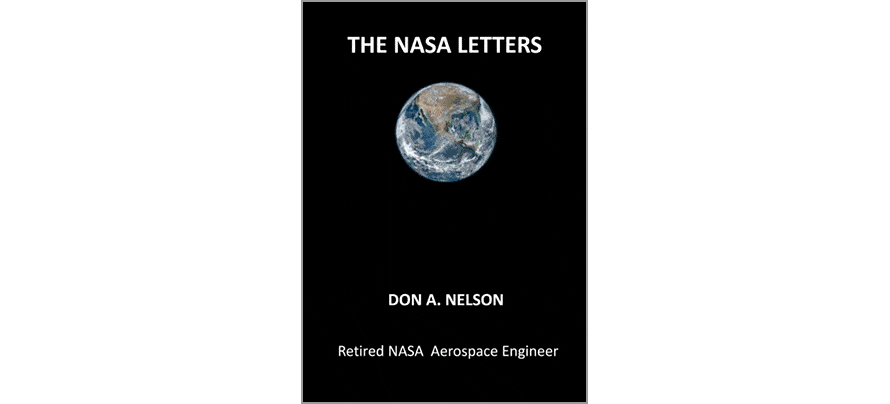Category: Nonfiction
Reviewed by: Robert A. Lee
Title: The NASA Letters
Author: Don A. Nelson
NSS Amazon link for this book
Format: Paperback/Kindle
Pages: 248
Publisher: CreateSpace
Date: August 2017
Retail Price: $9.95/$2.99
ISBN: 978-1542763882
Mr. Nelson, a retired NASA aerospace engineer, first began his career at NASA in Houston, Texas in 1963, by creating a computer program to simulate the Titan/Gemini launch trajectories. He continued working through the Apollo and Space Shuttle programs until his retirement in January of 1999. Much of this book consists of his personal correspondence with NASA management, both during his work tenure and after, as he urges them to modify the Space Shuttles to be fully autonomous, to provide crew escape pods, and to move them to the commercial sector instead of retiring them. Readers will learn of his attempts to convince upper management to perform safety studies comparing such a Shuttle to the new Space Launch System (SLS) and other launch vehicles, and to not assume any safety numbers without extensive analysis. After reading through the multiple letters whose advice seems to be ignored, NSS members may question whether our current space transportation program is on the path of providing a safer and more cost-effective infrastructure.
The book starts with some perceived flaws of the Apollo program that could also be an issue with the future Space Launch System. First, the non-reusable Saturn V’s were deemed unaffordable, and the SLS has many of the same characteristics. Second, expendable launchers are subject to manufacturing errors, and as stated in later chapters, “every new launch is a test flight.” Thus they are not necessarily safer than a reusable system. Finally, command modules for crews, like Apollo and Orion, may have safety issues upon reentry due to the weight limitations of parachutes and no viable escape for the crew if there is some catastrophe with the command module. The letters hit on these points multiple times, and the issue of safety and escape pods for the Space Shuttles is taken up in earnest next.
One of aftermaths of the Challenger 51L disaster, where Mr. Nelson was on the flight design and mission control team, was that crew escape pods for the Shuttles were analyzed. The analysis showed that the additional weight of these would make the craft nose heavy and unstable during reentry. The letters show Mr. Nelson urging NASA to consider replacing the shuttle pilots’ windows and displays with automation to allow for these escape pods. Since the Shuttles were already almost totally automated, with “the only pilot functions being the deployment of the wheels and drag chutes during landing,” the letters conclude that there were no technical issues prohibiting this development.
After working on the first 30 shuttle missions, Mr. Nelson spent his last 11 years at NASA working on “all of the advanced launch systems studies and supporting dozens of work groups.” His conclusion was that no expendable launch system was safer or more affordable than the decommissioned Shuttle. Thus, after retirement, he continued to write letters to NASA espousing the use of reusable pilotless systems for safety and cost. For example, he points out that the X-33, X-38 and X-40 demonstrate matured pilotless systems. In a 2002 letter to the Chairman of the NASA Aerospace Safety Advisory Panel, he urges that escape pods be reconsidered for the Space Shuttles to prevent another space tragedy. And the book provides a letter he sent to President George W. Bush again urging such action just before the Columbia disaster.
The correspondence provides some support for the notion that the safety estimates for our new systems are assumptions and guidelines, and not necessarily derived from extensive studies. One letter mentions that the NASA safety panel “is not a technical body” and does not verify the information that NASA has provided is correct. And Mr. Nelson points out that in the 2014 annual report to Congress, the NASA safety panel mentions on page 7 that the “SLS Orion programs…are not significantly safer than the actual historical performance of the Space Shuttle.” The letters conclude with his March, 2017 missive to President Trump urging a reusable, commercial space shuttle for both cargo and crew, and for a rapid launch capability for dealing with planetary defense.
Although I found the letters somewhat repetitive and a bit one-sided, there was enough here to make me wonder about autonomous launch vehicles—would I want to go up in a rocket ship without a pilot? Perhaps the idea was before it’s time. After all, many of us may soon be riding around as passengers in driverless cars. And, as a passenger, although I am not given a parachute when I board a plane, I may want an escape mechanism during a rocket launch, not only for ascent, but for reentry also.
I suspect there could have been many reasons why Nelson was mostly ignored, one being that his suggestions were prohibitively expensive for the extra amount of safety provided. But I think his voice deserves to be heard. After reading the letters, NSS members can ponder for themselves whether the Shuttles should have been modified and whether the SLS system is a sufficiently safe and cost-effective successor.
© 2017 Robert A. Lee
Please use the NSS Amazon Link for all your book and other purchases. It helps NSS and does not cost you a cent! Bookmark this link for ALL your Amazon shopping!



















